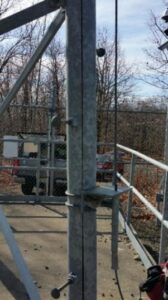Inspect Your Tower Regularly

[July 2024] Almost every list of “Good Practices” includes a regular inspection of a station’s tower(s) and antenna(s). But what should be included, how often, and how thoroughly often being in a wide list of variables to play. Bob Jellison shared his advice, based on over thirty years of inspecting towers and antennas.
When was the last time you had your tower and/or your antenna system physically inspected?
This is a very important task that, in most places, needs to be completed at least once a year. Most broadcasters will make sure the transmitter and studio are looked at constantly but avoid tower inspections as a way to save some money.
This mindset can save you some money upfront – but could cost you much more in the end.
ASSETS TO BE PROTECTED
Although not always immediately visible to station management and staff, the tower(s) and the antenna system are company assets and deserve the same respect and care as all the other items such as your studio and transmitter.
A lot happens at the tower site every day, and without the daily presence of personnel changes will go unnoticed. This is why inspections need to be performed consistently throughout the life of the equipment.
 In the image to the left you can see what happens if a Weep Hole gets clogged.
In the image to the left you can see what happens if a Weep Hole gets clogged.
Over time it can result in a split leg.

In the image to the right you can notice some coax that was not properly attached. It could be whipped around by wind to hit – and possibly damage other coax, antennas, dishes, etc.
This is why physical inspections should be completed for both of them – as both play a huge part in sending your programming out to your audience. Losing a tower and/or antenna will put most stations off the air. It is hard to make money or be a viable operation when the RF signal cannot get out to listeners.

This tower collapsed due to members rusting over an extended time without an inspection to identify and repair.
In fact, my years of experience show that such regular preventive maintenance goes a long way to keep your system on the air.
BOTH TOWER AND ANTENNA
The type of inspection will depend on the equipment in place at the tower site – and who owns the site.
Of course, if you own the tower, you will want to inspect both the tower and the antenna system. If you are co-located on a tower, your antenna system should be looked at as regularly.
This is necessary as any of the other systems co-located will constantly have tower crews working on it, especially if that tower contains cellular sites. This could lead to damage to your equipment like coax issues, having someone else’s equipment connected to yours, or someone possibly relocating your equipment to make it easier for them to install something else.
Trying to find out who was on that site will be a lot harder if a lot of time has passed since you were last there.
HANDS-ON IS NECESSARY
In recent years, some have been touting using drones to look at towers and antennas, seemingly obviating the need for someone to physically climb the tower.
While useful, you cannot rely on those results alone to be sure your system will remain operational at peak performance. It is true a drone inspection may cost less yet you cannot achieve the same result from a hands-on inspection. That is because a drone inspection can provide a visual of what is there, but it will never be able to give you the close-up information and evaluation an experienced climber would be able to provide.
And even if the drone does find something amiss, now you still will need to pay a crew to repair it at an additional expense. For example, perhaps a climber discovers something minor while on the tower such as a bad weatherseal on a tower member. Such an immediate diagnosis and fix could prevent water from damaging your coax. Similarly, not all metallic deterioration can be seen by a drone.
A QUICK LIST OF CONCERNS
A physical inspection should include a look at every system on the tower including:
- foundations
- clearance around the site
- wildlife and environmental issues
- structural
- grounding
- guy wires and guy tension measurements
- anchor points
- climbing systems
- lighting
- paint and rust
- weep holes
- coax
- the condition of hardware
- antenna mounts and support
- antenna(s)
Additional points of inspections can also include the shelter, radio equipment, sweep testing of the antenna systems, generators, security, access roads and gates, and other items.
It may take some time to properly budget for a regular inspection, but just like the insurance you have on your vehicles, building, or business operations, tower inspections serve as insurance against tower – and signal – loss. It is never too soon to get a quote from a reputable company and know, for sure, the condition of your tower(s) and antenna(s).
– – –
Bob Jellison is the Senior Project Manager for PPM Telecom. You can see Bob discuss this topic more deeply, with even more pictures on our BDR TLG video here.
– – –
Would you like to know when more articles like this are published? It will take only 30 seconds to click here and add your name to our secure one-time-a-week Newsletter list.
Your address is never given out to anyone.

